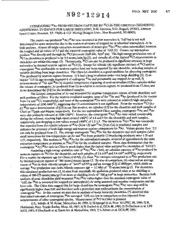
NASA Technical Reports Server (NTRS) 19920003696: Cosmogenic Ar-36 from neutron capture by Cl-35 in the Chico L6 chondrite: Additional evidence for large shielding PDF
Preview NASA Technical Reports Server (NTRS) 19920003696: Cosmogenic Ar-36 from neutron capture by Cl-35 in the Chico L6 chondrite: Additional evidence for large shielding
54th MET SOC 67 N92-12914 COSMOGENIC 36AtFROM NEUTRON CAPTURE BY 35C1IN THE CHICO L6 CHONDRITE: ADDITIONAL EVIDENCE FOR LARGE SHIELDING; D.H. Garrison, D.D. Bogard, (NASA, Johnson Space Center, Houston, TX 77058) & G.F. Herzog (Rutgers Univ., New Brunswick, NJ 08903). The cosmic-ray-produced mAr/mAr ratio measured in iron meteorites is"0.65 but isnot well determined for stone meteorites due tothe common presence of trapped Ar or adsorbed atmospheric Ar in bulk analyses. Almost allsingle-extraction measurements of stones give 36Ar/38Ar ratios intermediate between the trapped and air values of 5.3 and the expected cosmogenic value of "0.65 (1). Cosmic ray interactions produce 36Ar directly and through the 36C1precursor (half-life, 3x105yrs). The high-energy production rate of 36121in chondrites ispredicted to be 3-8 atoms/min/kg (2), and virtually allof the limited 36C1measurements in chondrites are within this range (3). Theoretically, 36CIcan also be produced in significant amounts in large meteorites by thermal neutron capture on 35C1(2). Except for Allende (4), significant excesses of 36C1and/or cosmogenic mAr attributable to neutron capture have not been reported for any chondrite, induding samples of variable shielding from large chondrites. The Chico L6 chondrite isa good candidate for observing cosmogenic 36Arproduced by neutron capture because: 1) ithad a long irradiation undervery large shielding (5); 2) an impact "0.5 Ga ago strongly degassed itof radiogenic 4°Ar and presumably any trapped Ar as well; 3) measurements of 37Ar and 38Ar bystepwise temperature degassing of neutron-irradiated Chico samples def'me the release of cosmogenic Ar produced from Ca inrelation to neutron-capture Ar produced from CIsites; and 4) we determined the [CI] for the irradiated samples. The isotopic composition ofAr was measured for stepwise temperature release ofboth chondritic and melt portions of Chico. For the neutron-irradiated samples, most of the 3TAr and 38Ar(produced inthe reactor from Ca and 37C1,respectively), and most of the cosmogenic 36Arwere released at relatively high extraction temperatures of 1100-1600°C, suggesting that CIcontamination isnot significant. From the reaction "_'CI(n,_, fl) 38Ar and a determination of [CI] inour flux monitor, we calculate [CI] for the chondrite and melt samples of Chico as 77ppm and 84ppm, respectively. For the two unirradiated Chico samples, cosmogenic 36Arand 3BAr were also primarily released at 1100-1500°C. However, the cosmogenic 36Ar/:_Ar ratio varied considerably during the releases, reaching high values around 1000°C of 4.4 and 9 for the chondritic and melt samples, respectively, and dropping to lowvalues around 1400°C of 1.2-1.3. The variation in:;6Ar/38Ar was essentially that expected from the relative releases of3BAr(from CI) and 37Ar (from Ca) inirradiated samples, and indicates the presence of both high-energy and neutron-capture components for :;6Ar. Values greater than "5.3 can only be produced from CI. The average cosmogenic 36Ar/38Ar for the chondritic and melt samples (after small corrections for low-temperature air Ar and 38Arfrom probable CIweathering products) were 1.76 and 2.27, respectively. The mamma in_Ar/38Ar for the unirradiated samples occurred at approximately the same extraction temperature as maxima in38Ar/37Ar for the irradiated samples. These data demonstrate that the cosmogenic 36Ar/38Ar ratio in Chico is much higher than the typical value accepted for chondrites of "0.65-0.7. Assuming a high-energy spallation ratio of 36Ar/38Ar =0.65, we calculate excesses of36Ar produced by neutron capture on 35C1for the chondritic and melt samples of 2.6xl0"8and 3.4 xl0"8ccSTP/g, respectively. For a cosmic ray exposure age for Chico of63 My (5), these 36Arexcesses correspond to a 36Ar production rate by thermal neutron capture of "300 atoms/minute/gram-Cl. By way of comparison, (4) observed an average excess of 36Atin their Allende samples of "2x10"8ccSTP/g and an average [CI] of 2800ppm, which yields an average _Ar production rate (with Allende exposure age = 5.2 My) of "70 atoms/min/g-Cl. For chondrites this calculated production rate (2, 6) rises from essentially the spallation-produced value at no shielding to values of 200-275 atoms/min/g-Cl or more at shielding levels of "300 g/era 2in large meteorites. Because bulk analyses of most chondrites yield measured 36Ar/38Ar ratios higher than the assumed cosmogenic value of "0.65, the 38Ar iscorrected for trapped (or atmospheric) Ar using assumed end-member components and the lever rule. The Chico data suggest that for large chondrites the cosmogenic 36Ar/aaAr ratio may well be significantly higher than 0.65 and therefore such a procedure may underestimate the concentration of cosmogenic 3BAr. In this context we note that inanalyses of many Antarctic chondrites (7) observed that determined amounts of eosmogenic _Ar averaged "13% too low in comparison to that expected from measurements of other cosmogenic species. Measurement of36C1in Chico isplanned. 1) L. Schultz & H. Kruse, Meteoritics 24, 1989;2) M.Spergel et al, Proc. 16LPSC, 91, 1986; 3) K. Nishiizumi, Nud. Tracks Radiat. Meas. 13, 1987;4) R.Goebel et al, GCA 46, 1982; 5) D.Garrison et al, LPS XXII, 1991; P.Eberhardt et al, Earth Sci. & Meteoritic.s, 1963; 7) L.Schutz et al, GCA 55, 1991.
